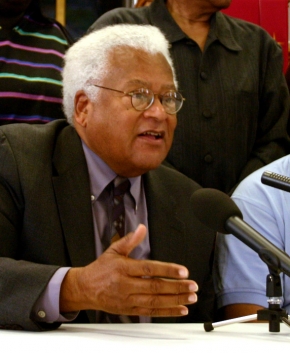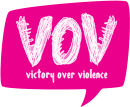A New Measure of Power
June 28, 2013

Martin Luther King Jr. once described Rev. James Lawson as the foremost nonviolence theorist in the world. In the late 1950's, after spending three years in India and ten years studying and practicing the methodology of Gandhian nonviolence, Rev. Lawson introduced the philosophy of nonviolent direct action to a generation of young southern activists engaged in the U.S. Civil Rights Movement. He inspired them to walk through their fears by focusing on their shared commitment to a larger cause. This inner battle provided an essential source of power for waging their nonviolent battle against injustice.
As part of our ongoing exploration of the virtue of courage, we would like to share an interview with Rev. James Lawson in which he describes how the unique convergence of courage, nonviolence and social action inspired a generation of youth to change the course of U.S. history. This interview was originally published in the July 2012 issue of SGI Quarterly.
"A New Measure of Power"
An interview with Rev. James Lawson
In the late 1950s, James Lawson moved to the southern US state of Tennessee and, as southern secretary of the Fellowship of Reconciliation, began training students in Nashville in nonviolent direct action. Prior to that, he had spent over a year in jail as a conscientious objector to the Vietnam War. The students Lawson trained launched sit-ins and other protest actions to challenge segregation in Nashville. Many of them became key figures in the Civil Rights Movement.
An example of the fortitude of the Nashville students was seen during the Freedom Rides. In 1961, a group of activists planned to travel by bus through the southern states to challenge the segregation of public transport. In Anniston, Alabama, a bus they were traveling on was firebombed by members of the Ku Klux Klan, and the Freedom Riders were savagely beaten, narrowly escaping being lynched. When the movement's leaders decided to suspend the journey, the students in Nashville were determined that violence should not be seen to triumph over nonviolent protest and, in place of the injured riders, continued the journey at the risk of their lives.
The Freedom Riders
Their actions gave vital impetus to the development of the Civil Rights Movement around the country. Described by Martin Luther King Jr. as the foremost nonviolence theorist in the world, Rev. Lawson, now in his 80s, remains a vibrant voice for social justice.
SGI Quarterly: Do you remember a particular moment after you became involved in the Civil Rights Movement when you felt afraid?
James Lawson: I recall a number of moments of fear. But, I should say to you that those are isolated moments, and that from the beginning of my involvement character requirements froze out any fear.
I was going to finish my graduate degree and then probably move south to work in the movement. I had spent three years in India in '53-'56 and then came back to Ohio for graduate school. I shook hands with Martin Luther King for the first time on February 6, 1957. I had been practicing and studying nonviolence from a Gandhian perspective of methodology for 10 years. And so as we met and talked, he said I should come south immediately. I said to him, "OK, I'll come just as soon as I can," which meant that I dropped out of graduate school and moved. There was no fear in making that move.
I don't recall a single moment as I traveled around the South that I was frightened or fearful. And as we began the movement in Nashville, I wasn't aware of any moment of fear there. I was expelled from the university--I had reenrolled at Vanderbilt University. I was made the target of many public attacks.
This is the movement that produced Diane Nash, Congressman John Lewis, Bernard Lafayette and C. T. Vivian, and a whole wide range of other people. Well, some of those people write about the fears they had in doing what they were doing. I had no such fear as we did it. Why? And of course for Diane and John Lewis and others, their fears largely evaporated as soon as we got past the first public demonstrations. Because they realized that they were fighting against that which is wrong--they knew that segregation was wrong, but they had not been given any clues as to how to go after defeating it. Our workshops in Nashville gave them the tools. Once we got past the first two weeks of demonstrations and once we got past the first violence and the first arrests, they had no fears.
Operating on fear is an issue of character. Courage is not merely, or primarily, the absence of fear. It is the taking on of tasks and concerns that are larger than the fear. It is discovering how to face your fears and moving through them as a whole person. That is what is essential. I know the testimonies of some of these persons with whom I worked back then; they found the conquest of fear. Now, for all of them there may have been certain times when the fear was very strong, but they managed by virtue of the tasks they had assigned themselves to walk through those fears and overcome them.
SGIQ: How did you train young activists in nonviolence?
JL: I gave them concrete experiences of black people, Europeans and others in nonviolent behavior in situations of conflict. I gave them a picture of Jesus of Nazareth as a nonviolence practitioner, and an interpretation of his life from the point of view of his direct action. I especially gave them the methodology of Gandhi, as I and others had come to summarize it in 1957-58, and made him and his independence movement a major illustration of what nonviolent power can do. I put together a curriculum that helped them see that there were people not much different from ourselves who had decided that there was a better way of changing evil, rather than imitating it; and that Gandhi had called all of that nonviolence.
Training for Nonviolence Resistance
Secondly, we worked on the scenery of segregation, what it was about, what downtown Nashville was about and how it deprived people. Then we did a series of role-playing exercises to help them face the possibilities of certain scenarios in their lives both at a personal level and then at the concrete level of the campaign we were devising.
I gave them the tools to live with tension and fear and to have a different vision and recognize that they have the resources within themselves to exercise that different vision.
With fear, if you follow it from the perspective of adrenalin, it will mislead you in your humanity. But if you follow the fear through the perspective of your character at its best or through the task of doing good--justice that needs to be done, the tasks at hand--then the fear becomes an ally for your work.
SGIQ: Is it right to say that the courage of the activists created a change in the hearts and attitudes of their opponents?
JL: Well, there is such a thing as a spirituality of nonviolence, the inner resources that one can shape and exercise that allows for the conquest of fear in a great variety of personal and social situations.
In the movement back then, society used two or three major tools to reinforce the racism. There was the threat that if you do not adhere to it, you are going to be punished. The second threat was the threat of actual violence. The third was that you would be arrested. And so in our workshops we tried to deal with all three of those elements by which Jim Crow segregation was put in place.
In the Nashville movement in 1960, there developed a spirit that came to laugh at all three of those threats.
Nashville Sit-Ins and Boycotts
In our movement--among our students and among our adults as well--those threats were destroyed in our minds and in our hearts and in the activity of the movement. So those powers that society had in Nashville for preserving segregation were no longer there in the minds of the people in the movement.
Lunch Counter Sit-ins in Nashville
During the bus boycott, Martin King said that the movement saw the "emergence of a new negro" in Montgomery, because people who joined the bus boycott basically told society, "You can threaten us, but it won't mean anything to us. You can use violence against us. We are not going to be intimidated by it, and you can arrest us and we are not going to fear going to jail for the cause." When the city government took out warrants against some 90 or 100 black folks in the boycott, people shocked the community and the police and the mayor, because they went to the police station to turn themselves in. The police had never heard of such a thing.
When the first group was arrested and officially booked, other people gathered. So there were some 90 other people outside the jail waiting to be booked and wanting to be booked and very cheerful about it. Well, that had never happened before in this country in these dimensions.
So it was astonishing that blacks who had stayed in place for 60 years, now suddenly are asking to be arrested. The threat of the jail is no longer an issue.
SGIQ: Is nonviolence a strategy, or is it more than that?
JL: I know there are people who do it only as a "tactic." But I don't know what that means, because we human beings are not "tacticians." We have more going on in our minds and in our spirits.
For human beings to act, we must have faith--confidence, trust--in what we do, whatever the methodology is, whatever the tactic is. And if we have doubts and fears that what we are doing will not work, we're finished.
When Gandhi says nonviolence is a social science for social change, I think he's including the intellect, the heart, the personality, the emotions, the tactics, the methodology and the philosophy that you have to develop to make this work. And I think it does become a lifestyle, just as when you launch a professional military career you develop a lifestyle, or when you become a lawyer you develop a lifestyle. In that lifestyle I think you can analyze methods and tactics versus spirituality, character. But in human beings it becomes a whole cloth, a whole garment.
Gandhi and Nonviolence
Today in Western civilization we have this massive mythology that the way you effect change is through violence, and that violence offers effective change. So nonviolence comes along and it has a critique of war, a critique of violence. We don't think violence has worked.
SGIQ: Many people are concerned about the state of the world. What do you think is necessary to galvanize people to stand against social injustices today?
JL: Basically to figure out that you do the kind of politics that was represented by the Civil Rights Movement. The politics of participation and engagement, developing the empowerment of people who bend their power together to put into the public agenda a new measure of power that can challenge the old powers.
When people collectively come together and strategize and plan, working together and acting together, they create a power that they can effectively use in their situation to effect change.


Comments:
There are no comments for this entry. Be the first to leave your own!